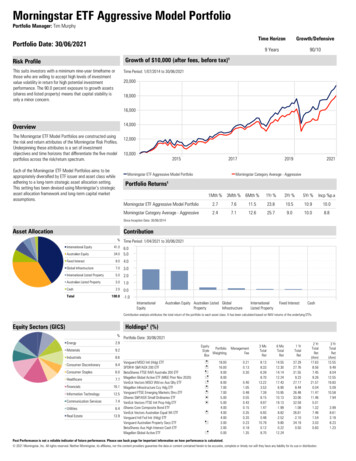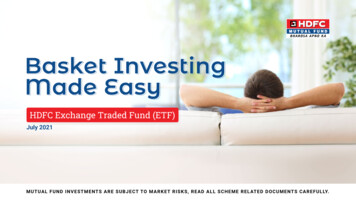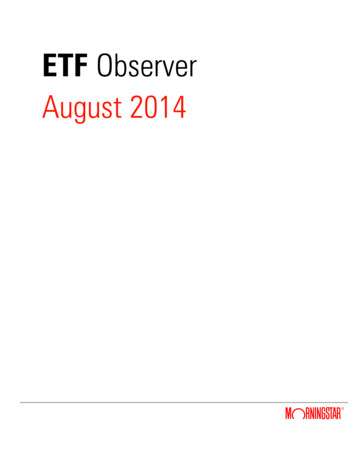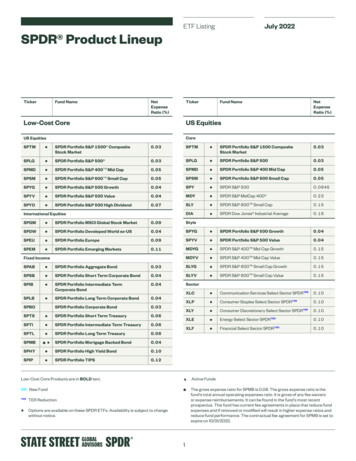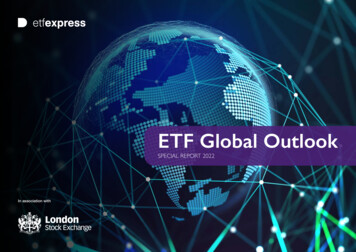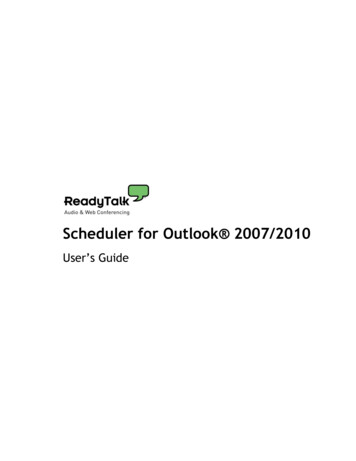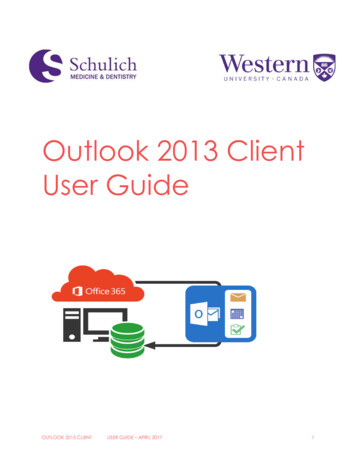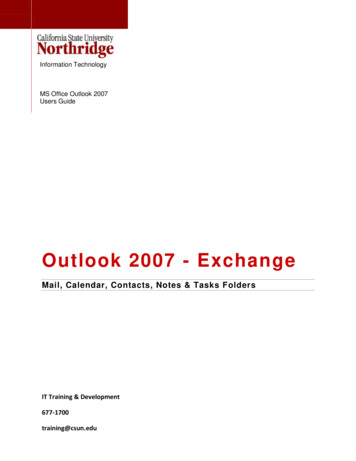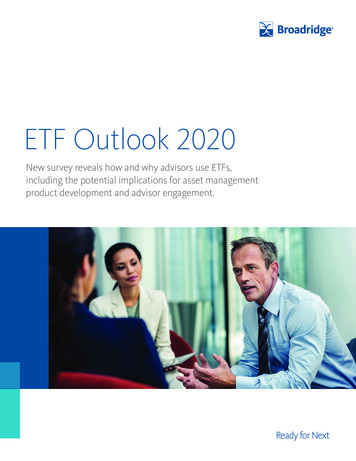
Transcription
ETF Outlook 2020New survey reveals how and why advisors use ETFs,including the potential implications for asset managementproduct development and advisor engagement.
INTRODUCTIONETFs enjoyed explosive growth duringthe last decade—expect that trend tocontinue well into this decade.Since the early 1990s, ETFs have drastically transformed theasset management industry. It’s no secret that investors continueto gravitate to ETFs. Low cost combined with tax efficiency is aformidable one-two punch. Plus, the popularity of passive indexinvesting makes ETFs a go-to option for many retail investors.Although the big story is well known, some of the detailsdemand greater scrutiny. Given the growth in ETF adoption, assetmanagers need more information about how and why financialadvisors (FAs) use ETFs, so they can respond effectively anddevelop a winning distribution strategy.This study provides insight into financial advisor behaviorsaround ETF investing. Our research uncovers the extent to whichadvisors have been increasing or decreasing use of ETFs and howthey plan to use ETFs in the future. Among other things, we showthe sources of information used to influence decision-making,the ETF products advisors prefer and the confidence advisorshave in their knowledge of ETFs.THE RESEARCHOn behalf of Broadridge, 8 AcrePerspective conducted a survey of513 FAs with at least 10M in AUM,and at least 10 percent of AUMallocated to ETFs. The survey reveals:Whether and to what extentETF use will keep growingWhy advisors choose ETFsand how they use themWhat factors influencedecision makingWhich asset managementfirms are most popularThis research includes only advisors who allocateat least 10 percent of AUM to ETFs and thereforethe data included in this study doesn’t necessarilyreflect advisor perspectives and allocations acrossthe entire industry.
The use of ETFs is not evenly distributed across financial advisors;there are notable differences in adoption by channel.DISTRIBUTION OF ADVISORS BASED ON ALLOCATION TO ETFsHEAVY (40% of AUM in ETFs)MEDIUM (20%–39% of AUM in ETFs)LOW (10% – 20% of AUM in ETFs)AVG AUMIN ETFsTOTALWireRegional/IBD22%14% 100M – 500M 500M 44%19%21%Age 4020%Age 40 –5425%Age 55 %38%44%27%23%43%44%27%35%43%23%RIA 100M43%31%37%26%29%26%
In the next few years, ETFs will likely surpass actively managed mutual fundsin advisor asset allocation.CURRENT ALLOCATION OF AUM BY PRODUCT TYPE (averages)Actively managedmutual fundsETFsIndividual securities10%9%7%Index mutual fundsSMAsAnnuities2%Other16%29%27%As ETFs become the primary choice for advisors, asset managers may be challengedto reconfigure fund line-ups and product development. Meanwhile, distributionheads will need to think through how to support sales and marketing.THE PAST TWO YEARS: CHANGE IN % OF AUM ALLOCATED TO ETFs83%IncreasedStayed the sameDecreased1%16%THE NEXT TWO YEARS: ANTICIPATED ALLOCATION TO ETFsWill increaseWill stay the sameWill decrease1%26%73%Averageincrease24.9%
Actively managed mutual funds will remain vulnerable as low-cost appealdrives ETF adoption.PRIMARY SOURCE OF ASSET SHIFTS TO ETFs55%Actively managedequity mutual funds15%Individual stocks14%Passive equity indexmutual funds9%Cash or equivalentsOtherAge 40: 64%Age 40-54: 55%Age 55 : 48%5%Fixed income(bonds or mutual funds)Younger advisors areeven more likely to shiftassets from activelymanaged funds to ETFs2%A younger generation of advisors tend to prefer low-cost ETFs to actively managedmutual funds. These findings indicate potential long-term shifts in productpreference as older advisors retire and transition their business.REASONS ADVISORS PLAN TO INCREASE USE OF ETFs(Coded open-ended responses)Low costTax-efficiency/tax benefitsExposures/diversificationBroad selection of ETFsPractice/advisor relatedClient demand/appealProduct featuresFlexibility of portfolio mgmtIssues with mutual fundsPerformanceFee pressureOther2%2%13%12%11%11%11%10%9%9%17%The above two charts include only advisors who say they plan to increase allocation to ETFs in the next two years (73% of respondents).49%
Interestingly, over 35 percent of advisors use ETFs as a core part of the portfolio.RIAs and large practices are more likely to use ETFs as core.HOW ETFs ARE USED: CORE VS. SATELLITE POSITIONSFairly evenmix of coreand rimarilysatellitepositionsADVISORS WHO USE ETFs AS PRIMARILY CORE POSITIONSBy ChannelWire31%IBD/Regional36%52%RIABy AUM 100M 100M – 500M 500M 31%36%48%
Advisors tend to favor broad market index ETFs vs. narrower product categories.TYPES OF ETFs USED IN CLIENT PORTFOLIOSU.S. Market Index73%Foreign Market IndexSector and LeveragedETNsForeign 4%2%Meanwhile, beyond Europe and Asia, interest in country-specific ETFsdrops dramatically.REGIONS OF INTEREST FOR FOREIGN MARKET ETFsEuropeAsiaChina27%26%26%BRICIndiaJapanLatin AmericaCanadaBrazilGermanySouth 7%7%5%4%3%6%14%14%13%13%20%38%56%64%95%
Thematic ETFs have not yet taken off and future demand is tepid.CURRENTLY INVEST IN THEMATIC ETFs(e.g. crypto-currency, solar, cannabis, etc.)LIKELIHOOD TO INVEST IN THEMATIC ETFs(Among respondents who do not currently invest in thematic ETFs)24%3%yes56%definitelywill76%41%noInterest in CannabisETFs is stronger in RIAand IBD channelslikelywill notprobablywillRIA:67%IBD/Regional: 61%Wire:42%THEMATIC ETFs OF INTEREST(Among those who invest in or are likely to invest in thematic ETFs)54%53%53%Clean energyCannabisReal estateInfrastructure5GWater resourcesNatural resourcesBlockchain/crypto currencyGaming and eSportsAgricultureOther7%17%24%31%39%46%43%50%
Although all the survey respondents use ETFs, more than a third do nothave strong confidence in their knowledge level. Asset managers may havean opportunity to improve advisor education.65%SELF-STATED KNOWLEDGE LEVEL OF ETFs7 point scale where7 extremely knowledgeable1 not at all knowledgeableHighconfidence(6-7)33%RIAs express more confidence:RIA:75%IBD/Regional: 62%Wire:64%Moderateconfidence(4-5)2%Not at all confident(1-3)Advisors are generally satisfied with the information available to them, howeveropportunities exist to strengthen these resources.RATING OF INFORMATION AND ANALYTICTOOLS TO EVALUATE AND SELECT ETFs46%31%16%7%FairGoodVery GoodExcellent
Morningstar is by far the most widely used website for ETF information.WEBSITES USED FOR ETF INFORMATIONMorningstar32%29%28%Seeking AlphaETF.comYahoo! Finance ETF Center17%ETF Database (etfdb.com)/ETF TrendsS&P Capital IQIBD ETF CenterETF GuideETF Daily NewsXTF5%4%3%2%74%11%Wholesalers and websites are the primary resources advisorsuse from ETF providers.RESOURCES LEVERAGED FROM ETF PROVIDERSWholesalersWebsitesWhite papers/thought leadership24%Conference %14%5%18%49%59%57%20%RIAs and IBD/Regionaladvisors are more likelythan Wire advisors to takeadvantage of webinars.WEBINARSRIA:32%IBD/Regional: 21%Wire:11%Wires are more likelyto use wholesalers whileRIAs are least likely.WHOLESALERSWire:71%IBD/Regional: 56%RIA:30%The data show clearopportunity for asset managersto deploy marketing resourceson websites and other digitalchannels to give advisors theinformation they need.
A small number of providers dominate the ETF space.ETF PROVIDERS USEDiShares (BlackRock)VanguardSPDR (SSGA)46%Invesco PowersharesFirst Trust Advisors28%WisdomTree aresFidelity InvestmentsPIMCOSchwabJP MorganVanEckGoldman SachsFlexSharesETF product preference is driven by provider product expertise and ETF legacy.IMPORTANCE IN SELECTING WHICH ETF PROVIDERS TO USE94%(Percentage citing as “very” or “somewhat” important when selecting an ETF provider)93%88%Long historyExpertise inwith ETFs specific categories/sectorsWide rangeof ETFs82%Value-addservice andsupport80%Known fordomesticand global72%Offers ETFeducation andresources64%Relationshipwith awholesaler
What’s next for ETFs?The research presented here helps illuminate why ETFsremain a primary choice for advisors. In previous studies,our research found a strong relationship between modelportfolio adoption and ETF growth. There is now morethan 1 trillion AUM in model portfolios, 42% of whichis allocated to ETFs. The research also confirms insightsfrom a separate study, which found that many advisors arebeginning to view nontransparent actively managed ETFsas a viable alternative to similar open-end mutual funds. Inthat survey, 83% of advisors somewhat or strongly agreewith the statement, “I hope my favorite active mutualfunds are introduced as nontransparent actively managedETFs.” This may set the stage for the next evolution in ETFs,further propelling gains in market share.Given advisor behaviors and the potential risk of losingmarket share, asset managers may consider rethinkingtheir go-forward product and distribution strategy.RELATED RESEARCHLearn more Learn more
Distribution InsightSee your true market opportunity across active andpassive products—including mutual funds and ETFs.Broadridge Distribution Insight delivers the analytics and strategicexpertise asset managers need to stay in front of fast-moving trends andmake more informed, confident decisions. Track asset flows, measuremarket share, identify opportunities and benchmark sales performanceacross U.S. and global markets. Partnering side-by-side, we’ll help createa distribution strategy to execute on every opportunity.NAVIGATE COMPLEX MARKETSWITH CONFIDENCE80Kfunds tracked globally 70Tassets tracked globallyFor more insights, contact matthew.schiffman@broadridge.comor visit: broadridge.com/resource/distribution-insight 15Tintermediary-held funds and ETFs 5Tintermediary-held ETF AUM
STUDY METHODOLOGY513 financial advisors who met the following criteria: Work in Wire, Regional, IBD or RIA channel 10M AUM 10% of AUM allocated to ETFsPROFILE RESPONDENTSPractice typeChannelWirehouse: 45%Solo: 44%IBD: 31%Team: 56%RIA: 14%Regional: 10%AUM (Millions) 10– 50: 13% 50– 100: 22% 100– 200: 26% 200 : 39%Median: 158Mean: 234FIELD PERIOD NOVEMBER 8 – DECEMBER 5, 2019
Broadridge, a global Fintech leader with over 4 billion in revenues and part of theS&P 500 Index, provides communications, technology, data and analytics. We helpdrive business transformation for our clients with solutions for enriching clientengagement, navigating risk, optimizing efficiency and generating revenue growth.broadridge.com 2020 Broadridge Financial Solutions, Inc., Broadridge and the Broadridgelogo are registered trademarks of Broadridge Financial Solutions, Inc.CommunicationsTechnologyData and Analytics
around ETF investing. Our research uncovers the extent to which advisors have been increasing or decreasing use of ETFs and how they plan to use ETFs in the future. Among other things, we show the sources of information used to influence decision-making, the ETF products advisors prefer and the confidence advisors have in their knowledge of ETFs.
